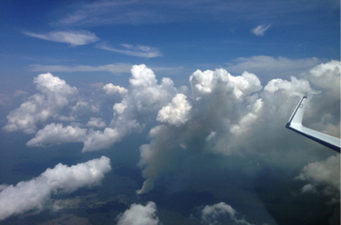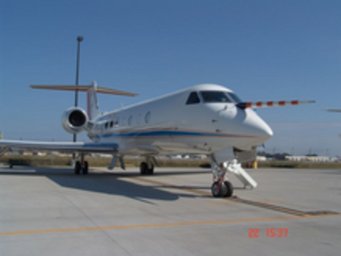Cloud towers above the Amazon
Scientists have successfully studied the formation of clouds and precipitation above the Brazilian rainforest with the research aircraft HALO
"Please buckle up. We are flying through an area with strong turbulence.” Some passengers might be petrified by such an announcement, but the atmosphere and climate researchers from Germany, Brazil and Israel were delighted last month to hear these words. Within the framework of a large-scale expedition, more than 60 scientists explored high rising cloud towers above the Amazon rainforest with the research aircraft HALO. The aim of the ACRIDICON-CHUVA measuring campaign was to find out how gases and aerosol particles, cloud drops and ice crystals, wind and solar radiation interact in the atmosphere and thus influence the formation and properties of clouds and precipitation, as well as their impact on the climate.
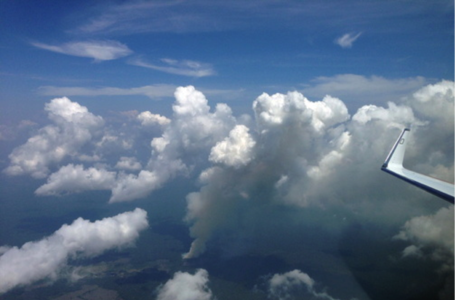
In 14 measuring flights, leaving from Manaus, Brazil, the researchers flew over the rainforest for about seven hours each and high into the atmosphere. In this context, the aircraft often flew into so-called convective clouds, the term which the meteorologists use for ascending rain and storm clouds. The researchers had a combination of innovative and high-performance measuring instruments on board, which determine the composition and the physical-chemical properties of air and clouds.
“Among other things, we want to understand the influence of pollution on the formation of clouds,” says Meinrat O. Andreae from the Max Planck Institute for Chemistry in Mainz. “When large areas of forest are burnt down, huge amounts of smoke particles are created which rise into the atmosphere and influence cloud formation.” “Polluted clouds contain much more water droplets than clean clouds, however, the droplets are a lot smaller,” says Manfred Wendisch from the Leipzig Institute for Meteorology of the Leipzig University, explaining the first results. Therefore, polluted clouds form rain less quickly and appear brighter, as smaller droplets reflect more sunlight than larger ones.
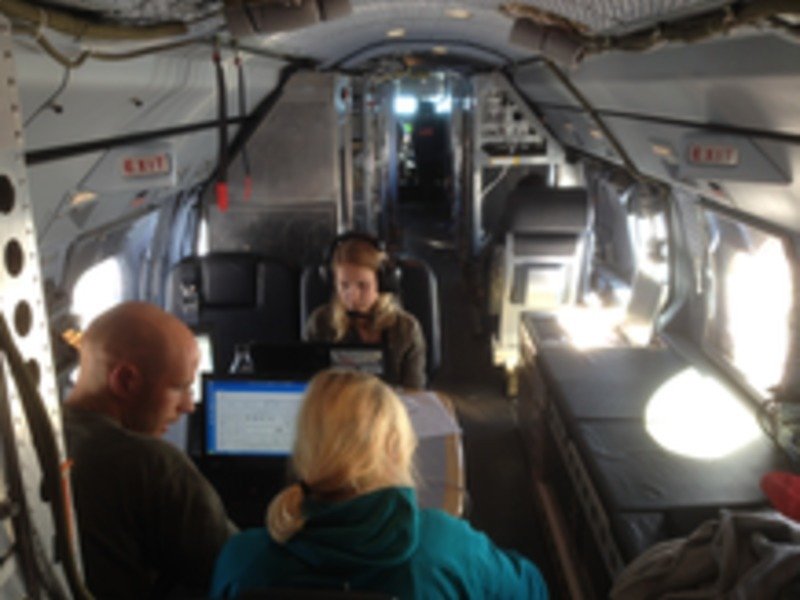
“On the HALO ACRDICON-CHUVA flights, for the first time, we were able to simultaneously measure and comprehensively characterize the chemical composition and microphysical properties of cloud particles, aerosol particles and trace gases in high convective clouds,” says Ulrich Pöschl from the Max Planck Institute for Chemistry, who coordinates the research project together with Meinrat Andreae, Manfred Wendisch and Luiz Machado from the Brazilian research institute INPE. “This makes it possible to record the process of cloud formation in more detail and to better understand and forecast the impact of air pollution on weather and climate.” However, it is still too early for quantitative statements on how the observed effects impact on the climate in the Amazonian rainforest and globally, as the researchers still need to analyze and assess the enormous amounts of data.
In addition to the enthusiasm for the unique scientific data, which the research aircraft HALO collected on its five-week assignment overseas, all participants were very happy that the measuring campaign could finally go ahead after many years of preparation and despite difficult logistical conditions. This would not have been possible without the close cooperation with the Brazilian partners.

Research flights near big storm cells, leading into larger cloud formations, are a pretty unusual task for the test pilots of the German Aerospace Center DLR which operates HALO. "The measurement flights are up to now the most complex flight operations for HALO,",says DLR test pilot Steffen Gemsa. "Particularly challenging aeronautically were the repeated overflights of cumulus clouds and of efflux areas of highreaching tropical thunderstorm clouds." The pilots flew five different scientific basic flight patterns at low altitudes over the Brazilian rainforest. In addition, they went up to extreme altitudes of nearly 15 kilometers. For these flights, the aircraft overcame regular temperature differences of more than 100 degrees Celsius. While the ground often reaches temperatures of over 35 degrees Celsius, temperatures in the upper troposphere are around minus 65 degrees Celsius. A lot of maintenance work on the aircraft and the measuring instruments needed to be dealt with, but no major technical problems occurred despite the tropical temperatures and turbulences. And all scientists on the aircraft also landed safely back on the ground.

About the ACRDIDICON - CHUVA measuring campaign
The abbreviation stands for Aerosol, Cloud, Precipitation, and Radiation Interactions and Dynamics of Convective Cloud Systems “(ACRIDICON)” and Portuguese word for “rain” (CHUVA).
Numerous images and a journal of the ACRIDON-CHUVA measuring campaign can be found on the following websites:
www.uni-leipzig.de/~meteo/acridicon-chuva/
acridicon-chuva.weebly.com
The German-Brazilian ACRIDICON-CHUVA research project is carried out in close cooperation with the Brazilian rain research project CHUVA, the US-Brazilian atmosphere research project GO-Amazon and the international Amazon research project LBA:
chuvaproject.cptec.inpe.br/portal/noticia.ultimas.logic
science.energy.gov/~/media/ber/pdf/Brochures/GOAMAZON_summary.pdf https://lba.inpa.gov.br/lba/lba_ingles/?p=19&lg=eng
The following institutes are directly involved in the ACRIDICON-CHUVA project:
The Max Planck Institute for Chemistry (MPIC), the Leipzig University, the German Aerospace Centre (DLR), the Research Institute Jülich (FZJ), the Leibniz Institute for Tropospheric Research (TROPOS), the Karlsruhe Institute for Technology (KIT), the Federal Institute for Physics and Technology (PTB), the Frankfurt University, the Heidelberg University, the Munich University and the Mainz University from Germany. The contribution of the university partners are financed by the German Research Foundation (DFG). Additional partners include the Hebrew University of Jerusalem, Israel as well as the Instituto Nacional de Pesquisas Espaciais (INPE), the Universidade de São Paulo (USP), the Centro Técnico Aeroespacial (CTA), the Sistema de Proteção da Amazônia (SIPAM) and the Instituto Nacional de Pesquisas da Amazônia (INPA) from Brazil.
About the research aircraft HALO
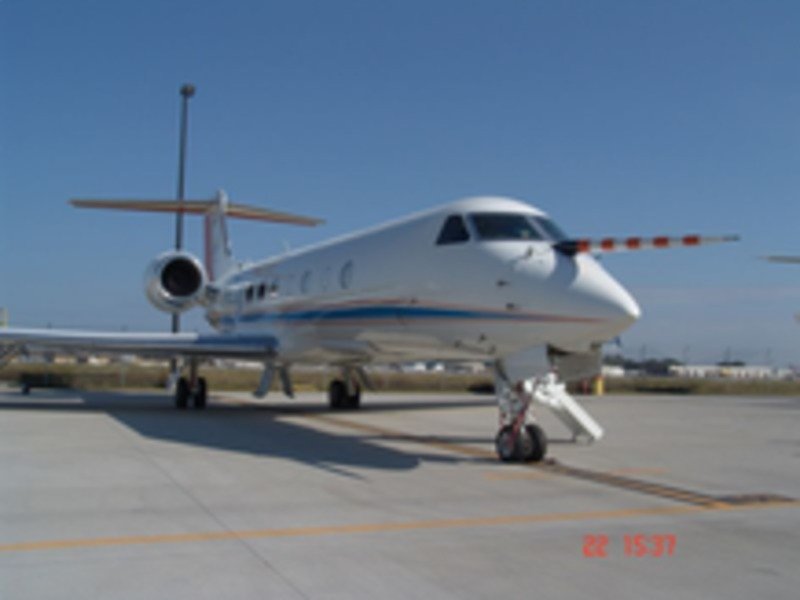
The HALO research aircraft is a collective initiative by German environment and climate research bodies. HALO is funded by contributions from the German Federal Ministry of Education and Research (Bundesministerium für Bildung und Forschung; BMBF), the German Research Foundation (Deutsche Forschungsgemeinschaft; DFG), the Helmholtz Association, the Max Planck Society, the Leibniz Association, the Free State of Bavaria, the Karlsruhe Institute of Technology, the German Research Centre for Geosciences (Deutsches GeoForschungsZentrum; GFZ), the Jülich Research Centre (Forschungszentrum Jülich) and the German Aerospace Center (Deutsches Zentrum für Luft- und Raumfahrt; DLR).
